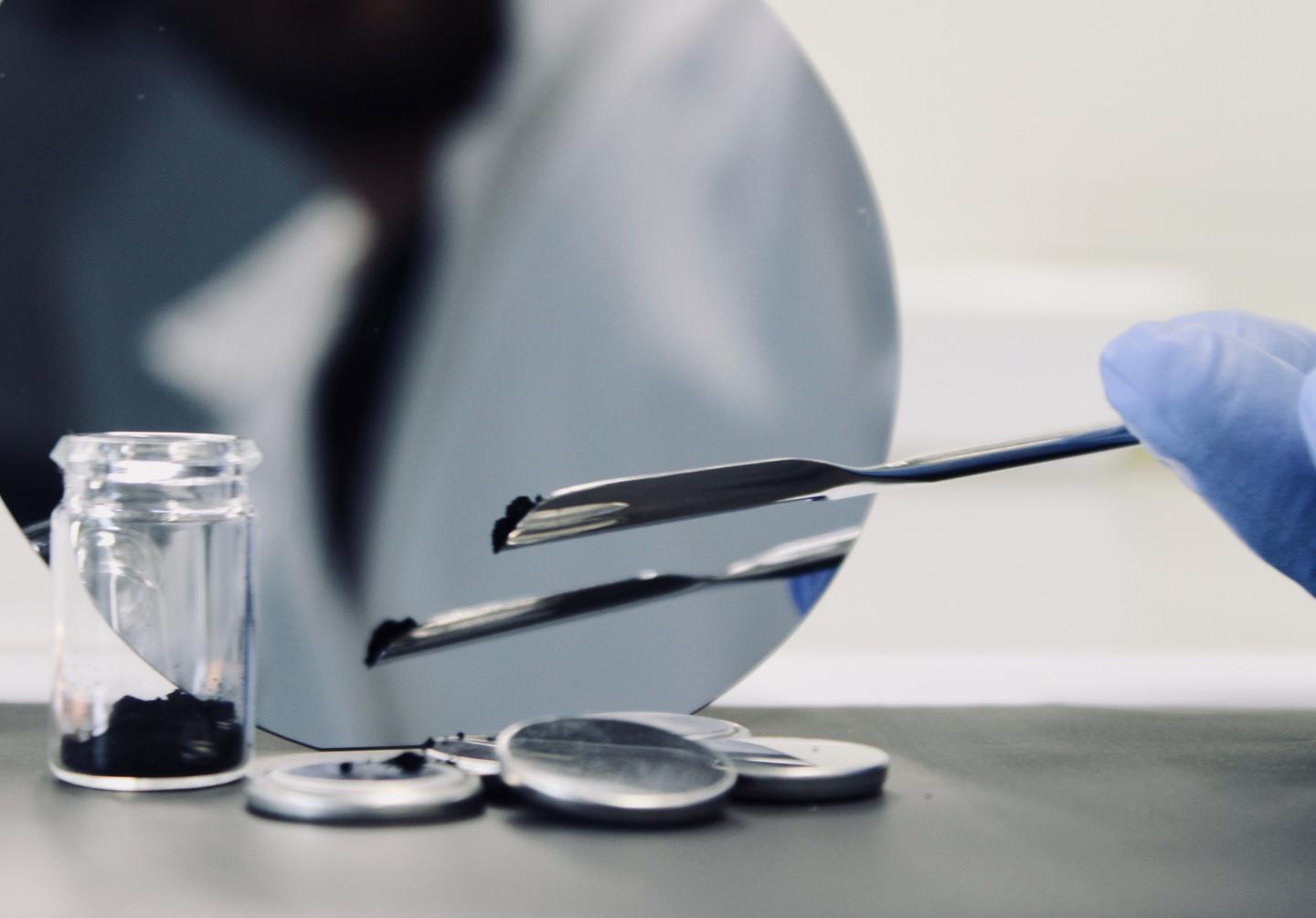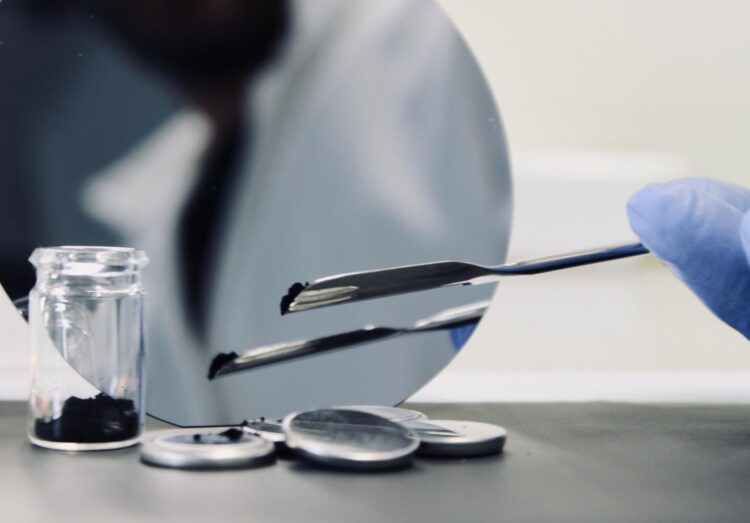Lithium lanthanum titanate particles enable high power densities even in micrometer sizes – publication in Nature Communications

Credit: Julia Maibach, KIT
Researchers at Karlsruhe Institute of Technology (KIT) and Jilin University in Changchun/China investigated a highly promising anode material for future high-performance batteries – lithium lanthanum titanate with a perovskite crystal structure (LLTO). As the team reported in the Nature Communications journal, LLTO can improve the energy density, power density, charging rate, safety, and cycle life of batteries without requiring a decrease of the particle size from micro to nano scale. (DOI: 10.1038/s41467-020-17233-1)
The demand for electric vehicles is increasing, accompanied by a growing need for smart grids that ensure a sustainable energy supply. These and other mobile and stationary technologies require suitable batteries. Storing as much energy as possible in the smallest possible space with the lowest possible weight – lithium-ion batteries (LIB) still meet this requirement best. The research aims at improving the energy density, power density, safety, and cycle life of these batteries. The electrode material is of major importance here. Anodes of lithium-ion batteries consist of a current collector and an active material applied to it that stores energy in the form of chemical bonds. In most cases, graphite is used as the active material. However, negative electrodes made of graphite have a low charging rate. Moreover, they are associated with safety issues. Among the alternative active materials, lithium titanate oxide (LTO) has already been commercialized. Negative electrodes with LTO present a higher charging rate and are considered to be safer than those made of graphite. The drawback is that lithium-ion batteries with lithium titanate oxide tend to have a lower energy density.
The demand for electric vehicles is increasing, accompanied by a growing need for smart grids that ensure a sustainable energy supply. These and other mobile and stationary technologies require suitable batteries. Storing as much energy as possible in the smallest possible space with the lowest possible weight – lithium-ion batteries (LIB) still meet this requirement best. The research aims at improving the energy density, power density, safety, and cycle life of these batteries. The electrode material is of major importance here. Anodes of lithium-ion batteries consist of a current collector and an active material applied to it that stores energy in the form of chemical bonds. In most cases, graphite is used as the active material. However, negative electrodes made of graphite have a low charging rate. Moreover, they are associated with safety issues. Among the alternative active materials, lithium titanate oxide (LTO) has already been commercialized. Negative electrodes with LTO present a higher charging rate and are considered to be safer than those made of graphite. The drawback is that lithium-ion batteries with lithium titanate oxide tend to have a lower energy density.
The team around Professor Helmut Ehrenberg, head of the Institute for Applied Materials – Energy Storage Systems (IAM-ESS) of KIT, now investigated another highly promising anode material: lithium lanthanum titanate with a perovskite crystal structure (LLTO). According to the study, which was carried out in collaboration with scientists from Jilin University in Changchun (China) and other research institutes in China and Singapore, LLTO anodes have a lower electrode potential compared to commercialized LTO anodes, which allows for a higher cell voltage and a higher capacity. “Cell voltage and storage capacity ultimately determine the energy density of a battery,” explains Ehrenberg. “In the future, LLTO anodes might be used to build particularly safe high-performance cells with a long cycle life.” The study contributes to the work of the research platform for electrochemical storage, CELEST (Center for Electrochemical Energy Storage Ulm & Karlsruhe), one of the largest battery research platforms worldwide, which also includes the POLiS excellence cluster.
Besides energy density, power density, safety and cycle life, the charging rate is another determining factor for the suitability of a battery for demanding applications. In principle, the maximum discharge current and the minimum charging time depend on the ion and electron transport both within the solid body and at the interfaces between the electrode and electrolyte materials. To improve the charging rate, it is common practice to reduce the particle size of the electrode material from micro to nano scale. The study, which was published in the Nature Communications journal by KIT researchers and their cooperation partners, shows that even particles of a few micrometers in size in LLTOs with a perovskite structure feature a higher power density and a better charging rate than LTO nanoparticles. The research team attributes this to the so-called pseudocapacitance of LLTO: Not only are individual electrons attached to this anode material, but also charged ions, which are bound by weak forces and can reversibly transfer charges to the anode. “Thanks to the larger particles, LLTO basically enables simpler and more cost-effective electrode manufacturing processes,” explains Ehrenberg.
###
Original publication (Open Access):
Lu Zhang, Xiaohua Zhang, Guiying Tian, Qinghua Zhang, Michael Knapp, Helmut Ehrenberg, Gang Chen, Zexiang Shen, Guochun Yang, Lin Gu & Fei Du: Lithium lanthanum titanate perovskite as an anode for lithium ion batteries. Nature Communications, 2020. DOI: 10.1038/s41467-020-17233-1
More about the KIT Energy Center: http://www.
Further material:
Publication in Nature Communications:
https:/
Being “the Research University in the Helmholtz Association,” KIT creates and imparts knowledge for the society and the environment. It is the objective to make significant contributions to the global challenges in the fields of energy, mobility, and information. For this, about 9,300 employees cooperate in a broad range of disciplines in natural sciences, engineering sciences, economics, and the humanities and social sciences. KIT prepares its 25,100 students for responsible tasks in society, industry, and science by offering research-based study programs. Innovation efforts at KIT build a bridge between important scientific findings and their application for the benefit of society, economic prosperity, and the preservation of our natural basis of life. KIT is one of the German universities of excellence.
This press release is available on the internet at http://www.
Media Contact
Monika Landgraf
[email protected]
Original Source
https:/
Related Journal Article
http://dx.





